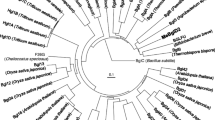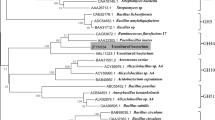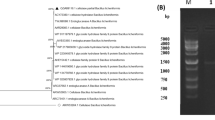Abstract
A glucoside hydrolase gene, egl01, was cloned from the soil DNA of Changbai Mountain forest by homologous PCR amplification. The deduced sequence of 517 amino acids included a catalytic domain of glycoside hydrolase family 5 and was homologous to a putative cellulase from Bacillus licheniformis. The recombinant enzyme, Egl01, was maximally active at pH 5 and 50 °C and it was stable at pH 3–9, 4–50 °C, and also stable in the presence of metal ions, organic solvents, surfactants and salt. Its activity was above 120 % in 2–3 M NaCl/KCl and over 70 % was retained in 1–4 M NaCl/KCl for 6d. Egl01 hydrolyzed carboxymethyl cellulose, beechwood xylan, crop stalk, laminarin, filter paper, and avicel but not pNPG, indicating its broad substrate specificity. These properties make this recombinant enzyme a promising candidate for industrial applications.




Similar content being viewed by others
References
Annamalai N, Rajeswari MV, Elayaraja S, Balasubramanian T (2013) Thermostable, haloalkaline cellulase from Bacillus halodurans CAS1 by conversion of lignocellulosic wastes. Carbohydr Polym 94:409–415
Carroll A, Somerville C (2009) Cellulosic biofuels. Annu Rev Plant Biol 60:165–182
Cucurachi M, Busconi M, Marudelli M, Soffritti G, Fogher C (2013) Direct amplification of new cellulose genes from woodland soil purified DNA. Mol Biol Rep 40:4317–4325
Itoh N, Isotani K, Makino Y, Kato M, Kitayama K, Ishimota T (2014) PCR-based amplification and heterologous expression of Pseudomonas alcohol dehydrogenase genes from the soil metagenome for biocatalysis. Enzyme Microb Technol 55:140–150
Javier Izquierdo A, Maria Sizova V, Lee Lynd R (2010) Diversity of bacteria and glycosyl hydrolase family 48 genes in cellulolytic consortia enriched from thermophilic biocompost. Appl Environ Microbiol 76:3545–3553
Lange JP (2007) Lignocellulose conversion: an introduction to chemistry, process and economics. Biofuel Bioprod Biorefin 1:39–48
Li X, Yu HY (2012) Purification and characterization of an organic-solvent-tolerant cellulase from a halotolerant isolate, Bacillus sp. L1. J Ind Microbiol Biotechnol 39:1117–1124
Liang C, Xue Y, Fioroni M, Rodríguez-Ropero F, Zhou C, Schwaneberg U, Ma Y (2011) Cloning and characterization of a thermostable and halo-tolerant endoglucanase from Thermoanaerobacter tengcongensis MB4. Appl Microbiol Biotechnol 89:315–326
Liu J, Liu WD, Zhao XL, Shen WJ, Cao H, Cui ZL (2011) Cloning and functional characterization of a novel endo-β-1,4-glucanase gene from a soil-derived metagenomic library. Appl Microbiol Biotechnol 89:1083–1092
Nacke H, Engelhaupt M, Brady S, Fischer C, Tautzt J, Daniel R (2012) Identification and characterization of novel cellulolytic and hemicellulolytic genes and enzymes derived from German grassland soil metagenomes. Biotechnol Lett 34:663–675
Natesan B, Nelson S (2014) Bacillus pumilus S124A carboxymethyl cellulase; a thermo stable enzyme with a wide substrate spectrum utility. Int J Biol Macromol 67:132–139
Trivedi N, Gupta V, Kumar M, Kumari P, Reddy CR (2011) An alkali-halotolerant cellulase from Bacillus flexus isolated from green seaweed Ulva lactuca. Carbohydr Polym 83:891–897
Waldeck J, Daum G, Bisping B, Meinhardt F (2006) Isolation and molecular characterization of chitinase-deficient Bacillus licheniformis strains capable of deproteinization of shrimp shell waste to obtain highly viscous chitin. Appl Environ Microbiol 72:7879–7885
Wang CY, Hsieh YR, Ng CC, Chan H, Lin HT, Tzeng WS (2009) Purification and characterization of a novel halostable cellulase from Salinivibrio sp. strain NTU-05. Enz Microb Technol 44:373–379
Xu JX, He BF, Wu B, Wang B, Wang C, Hu L (2014) An ionic liquid tolerant cellulase derived from chemically polluted microhabitats and its application in in situ saccharification of rice straw. Bioresour Technol 157:166–173
Zhu C, Xu Z, Song R (2011) The endoglucanase from Bacillus subtilis BEC-1 bears halo-tolerant, acidophilic and dithiothreitol-stimulated enzyme activity. World J Microb Biotechnol 27:2863–2871
Acknowledgments
This work was supported by National Natural Science Foundation of Jilin, China (Grant No. 20140101137JC) and State Key Laboratory Program of Microbial Technology of Shandong University.
Supporting information
Supplementary Table 1- Effect of metal ions and chemical reagents on Egl01.
Author information
Authors and Affiliations
Corresponding authors
Electronic supplementary material
Below is the link to the electronic supplementary material.
Rights and permissions
About this article
Cite this article
Hua, M., Zhao, S., Zhang, L. et al. Direct detection, cloning and characterization of a glucoside hydrolase from forest soil. Biotechnol Lett 37, 1227–1232 (2015). https://doi.org/10.1007/s10529-015-1777-5
Received:
Accepted:
Published:
Issue Date:
DOI: https://doi.org/10.1007/s10529-015-1777-5




